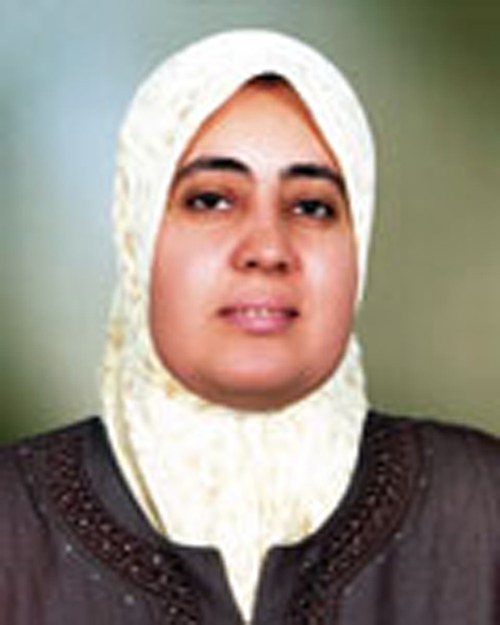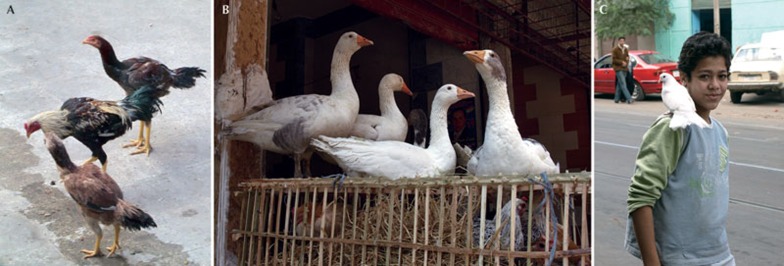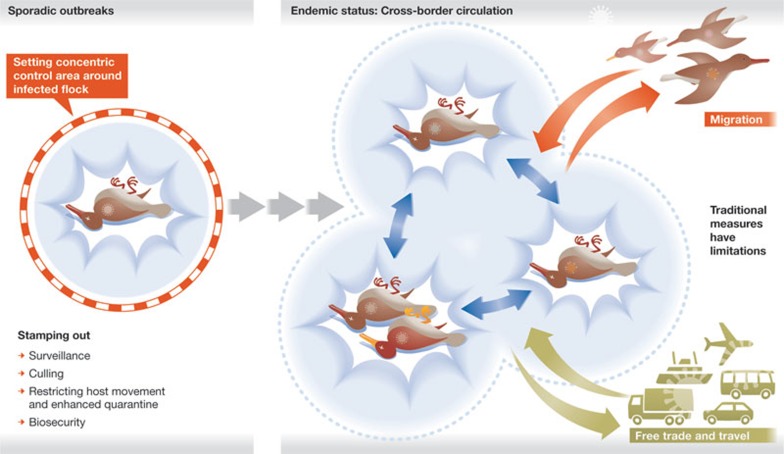The H5N1 virus has spread across Asia, Europe and Africa, and has infected birds in several endemic areas, including China, Indonesia, Vietnam and Egypt. H5N1 outbreaks pose a massive threat for the poultry industry and, ultimately, for human health [1]. However, the rapid spread of the virus also offers the opportunity to study and learn from its dynamics in the wild. The insights gained should inform new public health policies and preventive actions against a possible pandemic.
Progress in influenza research has been impressive. In particular, the application of reverse genetics has led to the identification of mutations and reassortment changes that determine virus virulence. Perhaps the most significant results come from the two now infamous studies, published in Nature and Science, about the generation of recombinant H5N1 viruses that are transmissible in ferrets [2,3]. These advances show that we are steadily elucidating influenza virus at the molecular level. By contrast, our understanding of the dynamics of highly pathogenic influenza virus in the environment remains limited [4,5].
Highly pathogenic avian influenza (HPAI) is an important poultry disease. The major reservoir of the virus is wild waterfowl, and infected birds are usually asymptomatic as a result of long-term evolutionary adaptation [1,6]. After transmission from wild waterfowl to poultry, however, avian influenza viruses occasionally become highly pathogenic and can cause mortalities of up to 100% within 48 h of infection. The standard method for controlling an HPAI outbreak is the testing and culling of all infected poultry, and the setting up of a concentric control area around the infected flock.
The HPAI H5N1 virus, circulating in Eurasia and Africa, emerged in China around 1997 [1] but it only infected terrestrial birds at the time. Continuous transmission in poultry eventually allowed the virus to evolve, resulting in large outbreaks in China in 2005 with high mortality in wild waterfowl. The virus spread rapidly, probably though migratory birds, to Central Asia, Europe, the Middle East and Africa. Such ‘east to west’ movements of H5N1 viruses over comparably long distances have not since been recorded. Moreover, migrating wildfowl have begun to spread the virus intermittently between Asia and Siberia [7]. This H5N1 lineage is the longest-circulating HPAI virus that has been reported, and it has reached epizootic levels in both domestic and wild bird populations.
…the challenge is to understand the evolution of H5N1 to better predict new strains that could become a serious threat for human health
One of the striking characteristics of the H5N1 lineage, in contrast with other HPAI, is its infectivity toward mammals. H5N1 can be directly transmitted from birds to humans and cause severe disease, although it has a significantly lower transmissibility than seasonal influenza viruses [1]. So far, 608 cases of human H5N1 infections have been reported with 59% mortality [5]. Most human infections have resulted from close contact with H5N1-infected poultry or poultry products, and no sustained human–human transmission has as yet been documented. Nonetheless, a potential H5N1 pandemic remains a great concern for public health.
The viruses that caused the five influenza pandemics since 1900 arose by two mechanisms: reassortment among avian, human and swine influenza viruses, and accumulation of mutations in an avian influenza virus [1,8]. Triple reassortment between avian H5N1, swine H3N1 and H1N1 viruses, and double reassortment between avian H5N1 and H9N2 viruses has already been reported in Asia, which raises concerns about new reassortment viruses that could infect humans [9,10]. Meanwhile, research has identified some 80 genetic mutations that could increase infectivity of avian influenza viruses in mammals, and thus potentially facilitate avian influenza evolution to generate a pandemic strain [8,11]. H5N1 strains with some of these mutations have often been found in bird populations [5] and in human H5N1 strains [12]. Indeed, specific mutations that could confer switching in receptor-binding specificity were reported in H5N1-infected patients in Thailand [13]. The two controversial studies published in Nature and Science also showed how a handful of mutations might enable the H5N1 virus to be transmitted between humans [2,3]. Pathogenic variants of the H5N1 virus with a higher pandemic potential could naturally evolve; the challenge is to understand the evolution of H5N1 to better predict new strains that could become a serious threat for human health.
…continuous replication of H5N1 virus in Egypt has provided a valuable opportunity to study the impact of genetic evolution on phenotypic variation without reassortment
The evolutionary dynamics of the Egyptian H5N1 strains provide clues to understanding the pandemic potential of H5N1. The virus was introduced only once in Egypt, in early 2006, and spread among a variety of bird species, including chickens, ducks, turkeys, geese and quail [14]. The virus rapidly evolved to form a phylogenetically distinct clade that has since diverged into multiple sublineages [15]. Thus, continuous replication of H5N1 virus in Egypt has provided a valuable opportunity to study the impact of genetic evolution on phenotypic variation without reassortment.
After diversification in local bird populations, some new H5 sublineages have emerged in Egypt with a higher affinity for human-type receptors. Indeed, since their emergence in 2008, almost all human H5N1 strains in Egypt have been phylogenetically grouped into these new sublineages, which can be transmitted to humans with a higher efficacy than other avian influenza viruses. This might explain why, since 2009, Egypt has had the highest number of human cases of H5N1 infection, with more than 50% of the cases worldwide [5]. Fortunately, these Egyptian H5N1 sublineages still do not have binding affinity for receptors in the upper respiratory tract and, therefore, do not sustain transmission in humans. However, it increases the risk of H5N1 variants that are better adapted to humans after viral replication in infected patients.
…Egypt is regarded as the country with the highest H5N1 pandemic potential worldwide
The Egyptian H5N1 sublineages are also diversifying antigenically in the field, as some are no longer crossreactive to other co-circulating sublineages [15]. Moreover, faint traces of species-specific evolutionary changes have been detected [16], implying a change in their host species. It shows that the H5N1 virus has undergone significant diversification in Egypt during the past seven years. Of greater concern, however, are Egyptian H5N1 strains that carry mammalian influenza virus type PB2 and have lost the N-linked 158 glycosylation site in the top region of haemagglutinin [15,17], both of which can potentially facilitate viral transmission to humans. The genetic diversification of H5N1 virus in Egypt represents an increasing pandemic potential, and Egypt is regarded as the country with the highest H5N1 pandemic potential worldwide [18].
A similar situation exists in other geographical areas. Multiple clades and sublineages of H5N1 are co-circulating in Asia, occasionally enabling reassortment events within and beyond the viral subtypes in the field [19,20]. Several H5N1 strains with enhanced binding affinity to human-type receptors have been reported in Indonesia [12]. Similarly, avian and swine H5N1 strains with an altered receptor-binding preference have been isolated sporadically in Indonesia and Laos [21,22]. As in other areas, distinct groups of H5N1 viruses are circulating amongst themselves and with other avian influenza viruses, generating diverse viral phenotypes in nature. The evolutionary dynamics of H5N1 might even accelerate in the wild. H5N1 viruses diverge genetically in ducks [23]; they can transfer the virus over long distances by migration. Thus, the H5N1 virus has established a complex life cycle in nature with accelerated evolutionary dynamics. The pandemic threat of H5N1 remains a serious concern and might be increasing.
Control measures based on isolating and culling are still the gold standard for controlling the early phase of an H5N1 outbreak, and worked against the H5N1 outbreaks in Hong Kong in 1997 and in Thailand in 2004 [4]. However, this measure failed in several countries and made H5N1 endemic. Cross-border circulation of H5N1 further complicates implementation of a classical control strategy based on culling in the infected area.
In response, public health officials in several countries, including Egypt and Indonesia, advocate poultry vaccination as a preventive or adjunct control measure [1]. Although vaccination does not completely prevent infections, its proper use can help to control avian influenza outbreaks by reducing virus transmission from infected animals. However, it can also increase vaccine-driven evolution among avian influenza viruses. The endemic status of H5N1, which can cause devastating local epidemics, puts pressure on health officers to use a vaccine or a vaccination strategy that might eventually increase selective pressure and thereby accelerate H5N1 evolution. Given the high mutability and diversity of circulating viruses, it seems best to avoid using a vaccine based on a strain from a different geographical area because there would only be a partial antigen match; such a heterologous vaccine would only be effective in the short term compared with a homologous vaccine. During past control of H5N1 epidemics using imported vaccines, escape mutants have emerged within about a year of the start of vaccination, which made the epidemic even worse [14]. When a vaccination strategy is implemented in an endemic area, the vaccine seed strain should be selected from the same geographical area to try to get the longest possible protection. Vaccine seed virus selection must be periodically revised to produce well-matched and efficacious vaccines.
Close communication and workshops hold the greatest potential for controlling the H5N1 virus
In most cases, H5 vaccine for an endemic area comes from a foreign supplier. It would be necessary to enable foreign manufacturers to produce customized H5 vaccines based on epidemic strains from different areas. The best approach might be a plasmid-based reverse genetics system to construct vaccine seed viruses [1]. In egg-based production, which is the basis of flu vaccine production, the seed virus needs to be adapted for high growth. This time-consuming step carries the risk of antigenic changes during vaccine production. Yet, advances in influenza reverse genetics have led to the development of cell culture systems to produce recombinant viruses, which would enable rapid genetic mutagenesis and reassortment. Once reverse genetics generates a virus genome that is well adapted to growth in cell culture, the haemagglutinin and neuraminidase genes can be easily interchanged with those of other influenza viruses. In addition, virus growth in cell culture can shorten production time, which increases the probability of selecting a seed virus antigenically appropriate for the upcoming flu season, and enables a rapid increase in production if necessary [24].
A control strategy imposed without consideration of regional customs will not be successful
Given the zoonotic risks of influenza viruses to both humans and animals, the establishment of a vaccine production system applicable to both human and animal infections is an urgent issue. The capacity of vaccine production needs to be flexible for seasonal, pre-pandemic and pandemic vaccines. Advances in genetic engineering facilitate in vitro control of human- and avian-type receptor expression on cultured cells, which should allow both human and avian influenza viruses to grow in the same system. As vaccine production capacity based on cell culture develops, commercial production of H5N1 vaccines tailored to each geographical area should become possible. In addition, emergency vaccination guidelines, such as pre-pandemic vaccine stockpiling, expanding and accelerating vaccine production and setting vaccination priorities, should be formulated in a business–government partnership, to ensure pandemic preparation. There is no guarantee that the H5N1 virus will be the next pandemic influenza strain. However, exploring options for versatile vaccine manufacturing is a key to controlling zoonotic influenza viruses, including H5N1.
The complexity of H5N1 ecology also makes control of endemic H5N1 by vaccination a complex task. The problem is that antigenically different groups of viruses, which are not crossreactive, are often co-circulating in endemic areas. Circulation of viruses in each sublineage is not restricted in terms of geography or host species, which complicates efforts to use a vaccine produced against antigens from a single virus strain [15]. Of greater concern, H5N1 virus infects a variety of bird species [1], which means the vaccination targets have expanded. Bird species differ in their optimal vaccination protocol—for example, the single vaccination used routinely in chickens does not induce an adequate immune response in turkeys, which require multi-dose vaccination at an older age [25]. Furthermore, rearing many bird species and their hybrid breeds in uncontrolled confinement is common in H5N1 endemic countries, especially in rural areas. Therefore, the immunogenicity of existing vaccines is probably inadequate to protect all target species with a single vaccination scheme. Endemic H5N1 already forces public health officials to redefine vaccine development policy to improve both vaccine immunogenicity and vaccination regime.
Unfortunately, it is unlikely that science will ever produce a clear answer as to when, where and how the next pandemic influenza virus will emerge
Today, there are numerous techniques that could overcome these problems by increasing immunogenic potency and crossreactivity. Innovative vaccine formats—multivalent, universal, nasal and synthetic vaccines—possibly coupled with the use of adjuvants, could improve the global vaccine supply [24]. These new technologies should be applied as soon as possible. Nevertheless, no single technique can probably resolve the underlying complexity of H5N1 dynamics. Over-reliance on vaccination might therefore only worsen the situation. Vaccination can help control endemic H5N1 only when administered as part of an integrated control programme that includes surveillance, culling, restricting host movement and enhanced quarantine and biosecurity.
The complex evolutionary dynamics of the H5N1 virus are challenging host species barriers and the ecology brings H5N1 into close proximity to humans [1]. The close link between the virus and humans is a multifaceted phenomenon that can affect health in myriad ways. Thus, we need to redefine control strategies to address the nature of H5N1 dynamics. Surveillance is the basis of infection control in the field. Wild birds and their predators should be included as surveillance targets, thereby expanding the H5N1 host species range. Another drawback is the fact that epidemiological studies focus mainly on virus genotyping. Although genetic data is informative, the diversity of H5N1 viruses makes characterization based only on genetic traits difficult. Characterization of viral phenotypes—antigenicity, receptor-binding preference, pathogenicity and transmissibility—is equally important for investigating the evolutionary dynamics of H5N1 viruses in nature. We would need techniques to determine easily viral phenotype, in particular new rapid diagnostic systems that can be used for timely epidemiological investigations and rapid infection control measures [1]. For example, portable kits that can determine virus receptor specificity would allow field testing of whether a particular avian influenza virus strain has adapted to human-type receptors, thereby adding a new dimension for characterizing and assessing H5N1 outbreaks.
Our perception of H5N1 control should change from short-term hunting to long-term control
The large-scale slaughter of all known and suspected infected birds in H5N1 endemic countries is hugely expensive in terms of execution costs and compensation for lost poultry. Financial assistance from international organizations might be needed to promote the thorough implementation of such a policy. However, H5N1 endemic countries are not all poor nations and some have already built a certain level of technology infrastructure. Thus, transfer of epidemiological skills and concepts to local health officers and scientists is a priority. Overseas collaborations between technologically developed countries and their institutions, and H5N1 endemic countries and their institutions, should be established at a functional level. Close communication and workshops hold the greatest potential for controlling the H5N1 virus. Such projects supported by governments and funding agencies would encourage establishment of bilateral and multilateral relationships between developed countries and the developing countries, which are the epicentres of H5N1 outbreaks. Sharing information about risk and risk management is one of the key methods for reducing the threat of future H5N1 epidemics.
Globalization has had major benefits for international travel and trade, and sharing of information. The improvements in information technology have dramatically increased the speed and ease of data flow [26]. Intelligence networks facilitate instantaneous sharing of information and enable global warnings about potential hazards as well as problem-solving. Moreover, collaborative research centres, which have been established on reciprocal bases between scientifically advanced countries and institutes and overseas partner countries and institutes in Asia, Africa and Latin America, are important players in information networking—for instance the Institute Pasteur Network, the Mahidol Oxford Tropical Medicine Research Unit and Japan Initiative for Global Research Network on Infectious Diseases. Linking such laboratory-based networks should be the next step. This would have a profound synergistic effect by maximizing research capacity, human resources and geographic coverage to build a robust global-scale network for infection control.
However, regional socio-cultural issues can be a significant concern for virus control wherever accepted values and scientific understanding might differ. Multiple local and regional factors—customs, religion, politics and economics—can affect H5N1 control in an area. Successful implementation of an H5N1 control strategy depends largely on mutual understanding and consideration of local idiosyncrasies.
Some examples from Egypt show how regional identity can be closely linked with local public health initiatives. Egypt is an Islamic nation and bird meat is an important source of animal protein, and the only source in some rural areas [14]. A large proportion of Egyptian households in rural areas raise poultry. Although broiler and layer chickens are raised under modern hygienic controls on commercial farms, backyard birds are raised in open uncontrolled farms, leaving them free to interact with other birds (Fig 1A). The poultry meat trade depends mainly on live bird markets in traditional bazaars (Fig 1B), because of a preference for freshly slaughtered poultry. Pigeon towers are built on farms, backyards and roofs throughout villages to raise pigeons for eating. Generally, birds in Egypt are raised in proximity to humans (Fig 1C), which presents an increasing risk of human H5N1 infection in Egypt and establishment of endemic H5N1 in birds nationwide.
Figure 1.
Socio-cultural traditions in rearing birds for food in Egypt. (A) Free rearing of backyard birds. (B) Live birds at a downtown market. (C) An example of the intertwined relationship between birds and humans.
Such regional identity is inseparable from socio-cultural contexts, making fundamental change virtually impossible. Although there are many scenarios in which a local public health system could be improved by food safety standards and veterinary inspection or short-term closing of live bird markets for virus clearance, H5N1 control measures have to be implemented whilst respecting the intrinsic socio-cultural traditions in the region. A control strategy imposed without consideration of regional customs will not be successful. It is the local health officers and scientists who are best suited to address the enormous complexity and breadth of issues required for H5N1 control. They also experience H5N1 outbreaks in their area on a regular basis and have a great incentive to be involved in infection control. Therefore, it is important to include local expertise in planning and implementing a control strategy.
Science in an area such as infectious disease research can no longer be viewed as independent of societal needs…
Science is frequently looked at as if it can produce a ‘silver bullet’ to solve every problem. Early success in vaccine and antibiotic development also created a false sense of optimism that scientific methods could eliminate the risk of infection. However, the reality has turned out to be different—some infectious diseases remain uncontrollable and far from eradication. Given the mutable and diversifying nature of avian influenza viruses, there is a significant possibility that different avian influenza subtypes and strains do not follow a single evolutionary pathway. Unfortunately, it is unlikely that science will ever produce a clear answer as to when, where and how the next pandemic influenza virus will emerge. Our perception of H5N1 control should change from short-term hunting to long-term control. The ecology of H5N1 virus brings it into close proximity to humans. The most important strategy is to minimize contact between terrestrial poultry and wild waterfowl to segregate H5N1 in poultry, because H5N1 spread would be uncontrollable if it established a stable equilibrium in waterfowl. For example, H5N1 viruses in Siberia have not been consistently isolated each year from carcasses and faeces of wildfowl migrating from Asia [7]. This implies that H5N1 circulation in the wild still largely depends on occasional introduction from poultry. It is possible that trials to limit H5N1 infection in poultry would lead to a reduction in viral spread and a dwindling evolutionary path in nature. Infection control policy must abandon fixed strategies in favour of flexible ones to keep pace with the evolutionary dynamics of pathogens such as H5N1 (Fig 2).
Figure 2.
Changing dynamics of H5N1 virus in the field. Endemic H5N1 virus diversifies in nature, making traditional control measures extremely difficult.
Today's infection control strategy is becoming largely dependent on the reliability and accuracy of information networking. However, the vast flood of scientific information can hide erroneous information and easily mislead the public [26]. Of greater concern, globalization has prompted the centralization of capital and resources, which can lead to an overemphasis on certain research topics. As a consequence, research projects are often short term, without consideration of effects that might have a long-term social impact [27]. This has led to a debate about whether to limit publication of certain types of research or keep scientific information completely accessible. There is probably no easy answer to this. Our global society needs a more mature approach to support research projects that are accurate reflections of societal needs in public health. At the same time, the increasing links between science and society put more pressure on science to play a greater role in society. This is a serious dilemma—how to use science to solve societal problems whilst maintaining its autonomy [27]. Science in an area such as infectious disease research can no longer be viewed as independent of societal needs; we need to establish a balance between the pursuit of independent basic research and its application for solving clinical problems and crises.

Yohei Watanabe

Kazuyoshi Ikuta

Madiha S Ibrahim
Acknowledgments
We thank Y. Suzuki, T. Nakaya, Y. Okuno, K. Takahashi, T. Sasaki, T. Daidoji and R. Kubota-Koketsu for valuable advice and discussions. This work was supported by a Grant-in Aid for Scientific from the Ministry of Education, Culture, Sports, Science and Technology, Japan (grant numbers 23791134 and 23406017) and the Japan Society for the Promotion of Science (JPPS) through the ‘Bilateral Programs’ scheme.
Footnotes
The authors declare that they have no conflict of interest.
References
- Watanabe Y, Ibrahim MS, Suzuki Y, Ikuta K (2012) The changing nature of avian influenza A virus (H5N1). Trends Microbiol 20: 11–20 [DOI] [PubMed] [Google Scholar]
- Herfst S et al. (2012) Airborne transmission of influenza A/H5N1 virus between ferrets. Science 336: 1534–1541 [DOI] [PMC free article] [PubMed] [Google Scholar]
- Imai M et al. (2012) Experimental adaptation of an influenza H5 HA confers respiratory droplet 334 transmission to a reassortant H5 HA/H1N1 virus in ferrets. Nature 486: 420–428 [DOI] [PMC free article] [PubMed] [Google Scholar]
- OIE (2012) Update on highly pathogenic avian influenza in animals (type H5 and H7). http://www.oie.int/animal-health-in-the-world/update-on-avian-influenza/2012/
- WHO (2012) Cumulative number of confirmed human cases of avian influenza A(H5N1) reported 338 to WHO. http://www.who.int/influenza/human_animal_interface/H5N1_cumulative_table_archives/en/index.html
- Webster RG, Bean WJ, Gorman OT, Chambers TM, Kawaoka Y (1992) Evolution and ecology of influenza A viruses. Microbiol Rev 56: 152–179 [DOI] [PMC free article] [PubMed] [Google Scholar]
- Sakoda Y et al. (2010) Characterization of H5N1 highly pathogenic avian influenza virus strains isolated from migratory waterfowl in Mongolia on the way back from the southern Asia to their northern territory. Virology 406: 88–94 [DOI] [PubMed] [Google Scholar]
- Medina RA, Garcia-Sastre A (2011) Influenza A viruses: new research developments. Nat Rev Microbiol 9: 590–603 [DOI] [PMC free article] [PubMed] [Google Scholar]
- Dong G et al. (2011) Reassortant H9N2 influenza viruses containing H5N1-like PB1 genes isolated from black-billed magpies in Southern China. PLoS ONE 6: e25808. [DOI] [PMC free article] [PubMed] [Google Scholar]
- Zhou H, Zhang A, Chen H, Jin M (2011) Emergence of novel reassortant H3N2 influenza viruses among ducks in China. Arch Virol 156: 1045–1048 [DOI] [PubMed] [Google Scholar]
- Imai M, Kawaoka Y (2012) The role of receptor binding specificity in interspecies transmission of influenza viruses. Curr Opin Virol 2: 160–167 [DOI] [PMC free article] [PubMed] [Google Scholar]
- Yamada S et al. (2006) Haemagglutinin mutations responsible for the binding of H5N1 influenza A viruses to human-type receptors. Nature 444: 378–382 [DOI] [PubMed] [Google Scholar]
- Kongchanagul A, Suptawiwat O, Kanrai P, Uiprasertkul M, Puthavathana P, Auewarakul P (2008) Positive selection at the receptor-binding site of haemagglutinin H5 in viral sequences derived from human tissues. J Gen Virol 89: 1805–1810 [DOI] [PubMed] [Google Scholar]
- Abdelwhab EM, Hafez HM (2011) An overview of the epidemic of highly pathogenic H5N1 avian influenza virus in Egypt: epidemiology and control challenges. Epidemiol Infect 139: 647–657 [DOI] [PubMed] [Google Scholar]
- Watanabe Y, Ibrahim MS, Ellakany HF, Kawashita N, Daidoji T, Takagi T, Yasunaga T, Nakaya T, Ikuta K (2012) Antigenic analysis of highly pathogenic avian influenza virus H5N1 sublineages co-circulating in Egypt. J Gen Virol 93: 2215–2226 [DOI] [PubMed] [Google Scholar]
- Ibrahim MS, Watanabe Y, Ellakany HF, Yamagishi A, Sapsutthipas S, Toyoda T, Abd El-Hamied HS, Ikuta K (2011) Host-specific genetic variation of highly pathogenic avian influenza viruses (H5N1). Virus Genes 42: 363–368 [DOI] [PMC free article] [PubMed] [Google Scholar]
- Watanabe Y et al. (2011) Acquisition of human-type receptor binding specificity by new H5N1 influenza virus sublineages during their emergence in birds in Egypt. PLoS Pathog 7: e1002068. [DOI] [PMC free article] [PubMed] [Google Scholar]
- Yong E (2012) Mutant-flu paper published. Nature 485: 13–14 [DOI] [PubMed] [Google Scholar]
- Takano R, Nidom CA, Kiso M, Muramoto Y, Yamada S, Sakai-Tagawa Y, Macken C, Kawaoka Y (2009) Phylogenetic characterization of H5N1 avian influenza viruses isolated in Indonesia from 2003–2007. Virology 390: 13–21 [DOI] [PMC free article] [PubMed] [Google Scholar]
- Nguyen T et al. (2012) Evolution of highly pathogenic avian influenza (H5N1) virus populations in Vietnam between 2007 and 2010. Virology 432: 405–416 [DOI] [PubMed] [Google Scholar]
- Boltz DA et al. (2010) Emergence of H5N1 avian influenza viruses with reduced sensitivity to neuraminidase inhibitors and novel reassortants in Lao People's Democratic Republic. J Gen Virol 91: 949–959 [DOI] [PMC free article] [PubMed] [Google Scholar]
- Nidom CA et al. (2010) Influenza A (H5N1) viruses from pigs, Indonesia. Emerg Infect Dis 16: 1515–1523 [DOI] [PMC free article] [PubMed] [Google Scholar]
- Watanabe Y, Ibrahim MS, Ellakany HF, Abd El-Hamid HS, Ikuta K (2011) Genetic diversification of H5N1 highly pathogenic avian influenza A virus during replication in wild ducks. J Gen Virol 92: 2105–2110 [DOI] [PubMed] [Google Scholar]
- Rappuoli R, Dormitzer PR (2012) Influenza: options to improve pandemic preparation. Science 336: 1531–1533 [DOI] [PubMed] [Google Scholar]
- Kilany WH et al. (2011) Protective efficacy of H5 inactivated vaccines in meat turkey poults after challenge with Egyptian variant highly pathogenic avian influenza H5N1 virus. Vet Microbiol 150: 28–34 [DOI] [PubMed] [Google Scholar]
- Pang T, Guindon GE (2004) Globalization and risks to health. EMBO Rep 5: S11–S16 [DOI] [PMC free article] [PubMed] [Google Scholar]
- Weigmann K (2004) Fashion of the times. The emergence and evolution of new research fields is as much determined by scientific interest as it is by social, political and economic pressures. EMBO Rep 5: 1028–1031 [DOI] [PMC free article] [PubMed] [Google Scholar]




